Moses Jacob Ezekiel
Moses Jacob Ezekiel, also known as Moses "Ritter von" Ezekiel (October 28, 1844 – March 27, 1917), was an American sculptor who lived and worked in Rome for the majority of his career. Ezekiel was "the first American-born Jewish artist to receive international acclaim".[1][2]
Moses Jacob Ezekiel | |
|---|---|
 Ezekiel in 1914 | |
| Born | October 28, 1844 Richmond, Virginia, U.S. |
| Died | March 27, 1917 (aged 72) |
| Nationality | American |
| Education | Virginia Military Institute |
| Known for | Sculpture |
| Awards | New Market Cross of Honor |
He was a cadet at the Virginia Military Institute and served in the Confederate Army during the American Civil War, including at the Battle of New Market. He is the only well-known sculptor to have seen action in the Civil War.[3]
After the war, he completed his degree at VMI, and a few years later went to Berlin, where he studied at the Prussian Academy of Art. He moved to Rome, where he lived and worked most of his life, selling his works internationally, including as commissions in the United States.
He has been described as a "Confederate expatriate"[3] and a "proud Southerner",[4] and the Confederate battle flag hung in his Rome studio for 40 years.[3] The most famous of his monuments is the Confederate Memorial in Arlington National Cemetery, which he thought of as the "crowning achievement of his career."[5]
Childhood
Ezekiel was born in Richmond, Virginia, the son of Jacob Ezekiel (1812–1899), an Ashkenazic Jew. His mother, Catherine de Castro Ezekiel, was Sephardic.[6][7] His grandparents had emigrated from Holland in the early 1800s, settling first in Philadelphia and later in Richmond.[8]: 3 His father was a cotton merchant[7] and bookbinder, "a good writer and a well-read man, who possessed the complete works of Maimonides".[9]: 76 While in the book-binding business in Baltimore (1833–34), Jacob founded the Hebrew Benevolent Society of Baltimore.[10] Jacob moved to Richmond in 1834, entering the dry-goods business with first one, then another brother-in-law.[11]: 16 n. 10 He was secretary of the synagogue Kahal Kadosh Beth Shalome "and spokesman of the Jews of Richmond".[11]: 16 n. 10 In Cincinnati, Jacob served as Secretary of the Board of Hebrew Union College. He was a charter member of B'nai B'rith.[12]
The seventh child,[8]: 3 [nb 1] Moses had three brothers and eight sisters,[13][nb 2] at least one of which was stillborn.[9]: 88 He was brought up as an observant Jew by his grandparents, to whom his parents sent him to live due to financial difficulties.[4][8]: 3 [nb 3] They owned a dry-goods store that sold suits and women's dresses for slaves about to be sold. They also owned a few slaves.[3][5] Moses "was sent to a 'pay' school", that of "old Mr. Burton Davis",[9]: 91 and he attended dancing school.[9]: 85, 101
Virginia Military Institute and the Civil War

When Fort Sumter was fired upon and Virginia seceded, Ezekiel enrolled in the Virginia Military Institute in Lexington, Virginia,[7] the first Jewish cadet (student) to do so.[14] He was Corporal of the Guard that accompanied the coffin of Stonewall Jackson (a Virginia Military Institute instructor) at his burial in Lexington in 1863.[8]: 43 [11] He and other cadets from VMI marched 80 miles north and fought at the 1864 Battle of New Market. He was wounded in a fight with Union army troops under Franz Sigel. After his recovery, he served with the cadets in Richmond to train new recruits for the army. Shortly before the end of the war, he served in the trenches defending the city.[15]
Following the Civil War, Ezekiel returned to VMI to finish his education, graduating in 1866. He studied anatomy at the Medical College of Virginia in 1866–68, thinking of becoming a doctor.[9]: 127–128 [8]: 17 In 1867–68 he was superintendent of the Richmond Hebrew Sunday School.[16]
He moved in with his parents in Cincinnati in 1868; his parents had moved there, where their oldest daughter Hannah lived, after losing their business in Richmond to fire.[9]: 128 [8]: 17 While not there long, in his memoirs he calls Cincinnati his home.[17]
Sculpture
In Cincinnati he began the study of sculpture[3] at the Art School of J. Insco Williams and in the studio of Thomas Dow Jones.[9]: 130 [15] Moving to Berlin in 1869, he studied at the Prussian Academy of Art under Professor Albert Wolf.
Needing money, in 1873, during the Franco-Prussian War, he was a war correspondent for the New York Herald,[18]: 4 and he was arrested and imprisoned "for a time" as a spy for France.[6] He was admitted into the Society of Artists, Berlin, and at age 29 was the first foreigner to win the Michael Beer Prix de Rome, for a bas relief entitled Israel. The prize of $1,000 provided for two years of study in Rome,[19]: 229 but he traveled to Rome by way of the United States, where he had not been for five years,[9]: 166 as he had "unexpectedly" received a commission from B'nai B'rith for a monument to Religious Liberty.[9]: 164 [8]: 41
Rome studio
Arriving in Rome in 1874, he fell in love with the Eternal City, which he soon made his home. It was there that he completed the sculptures and paintings for which he is famous.
"Ezekiel found both personal and artistic freedom in Rome. He dressed like a dandy and spent extravagantly on entertaining friends, clients, and potential clients."[7] His studio in Rome was in the former Baths of Diocletian, where every Friday afternoon he had open house.[19]: 233 It was called "one of the Show Places of the Eternal City, magnificent in proportions and stored with fine art works."[20] and many visitors left descriptions of it.[18]: 24
Perhaps the most characteristic of his creations was the celebrated studio.… Here in the vaulted thermae built in the days of Diocletian he had gathered together treasures from many lands and ages. Ancient marbles and alabasters, bronzes, costly metals and relics beautified with precious stones, medieval parchments and church ornaments, oriental ivories, velvets and silks hung on all sides, in alluring contrast to the latter-day furniture and the twentieth century grand piano, proclaiming the broad sympathies and the catholic tastes of this citizen of the world.[21]: 230
— American Jewish Yearbook, 1917
Under a leafy arbor, a paved stairway leads up to a vineclad terrace, from which you have an extensive view of the surroundings. Doves have built their nests in the masonry and flit fearlessly to and fro about you. Works of art, vases, fragments of old armor, antique heads and ornaments gleam through the dark foliage. Artists' hands have appropriately ornamented the interior of the high hall; pillars, rich with carving of vines, uphold the arches; lamps and statuettes occupy the mantels; tapestries and paintings adorn the walls. Hours might be spent in examining the works of art, great and small, in this wondrous room. Nothing is commonplace: every seat, every cloth, every cup and dish, every furnishing, bears its individual stamp.[22]
— Brooklyn Daily Eagle, September 15, 1889
"His picturesque studio in the Baths of Diocletian was the rendezvous of all important American visitors and the most prominent representatives of art."[6] Among the visitors to his studio were:
- Gabriele d'Annunzio[9]: 201
- Queen of Italy Margherita of Savoy[9]: 414
- General and future President Ulysses Grant[9]: 198–199
- Franz Liszt[9]: 254
- U.S. ambassador to Italy John Stallo[9]: 259
- Cardenal Gustav Adolf Hohenlohe[9]
- writer Annie Besant[9]: 275
- railroad magnate Melville Ingalls[9]: 275
- engineer Benjamin Hotchkiss, and
- Emperor Wilhelm II of Germany[9]: 313
A lecture in his studio was attended by 150 people.[9]: 275 He also hosted musicales there,[23]: 42 where could be heard "the finest music by the greatest talent".[9]: 233
Ezekiel occupied this studio from 1879 to 1910.[23]: 42 After 30 years, the government "demand[ed] the possession of this part of the ruins as an adjunct to the National Roman Museum. On leaving there he was given by the municipal authorities the Tower of Belisarius on the Pincian Hill overlooking the Borghese Gardens, which furnished him a home for the rest of his years, while he took a studio and work rooms in the Via Fausta and just off the Piazza del Popolo."[19]: 226–234
Personal life
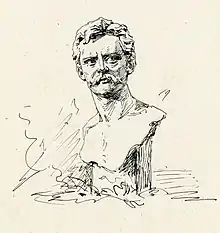
Although Ezekiel never married, he had a daughter, Alice Johnson (1859-1926). According to a census document of July 14, 1860, Alice Johnson was 10 months old, suggesting she was born in September 1859. She would therefore have been conceived at the beginning of 1859[24] when Moses was 14. Her mother was Isabella, a "beautiful mulatto housemaid" of his father.[24]: 148 After graduating from Howard University, Alice became a schoolteacher and married Daniel Hale Williams in 1898, who was also mixed race. He became a prominent, pioneering heart surgeon. They lived in Chicago for much of his career.[25][26][27]
Isabella visited Moses in Rome with Alice, but returned shortly thereafter. Moses never refers to Alice in his Memoirs, and there is no record of any other contact between them.
In 1872, in Berlin, he met Fedor Encke (1851–1926), the "illegitimate grandson of King Friedrich Wilhelm II of Prussia."[4] Encke was a portrait painter later commissioned to do portraits of Theodore Roosevelt and John Pierpont Morgan, among others; he also painted Ezekiel.[8]: i The pair "traveled together often and socialized with Europe's elites, including Hungarian composer Franz Liszt, French actress Sarah Bernhardt and Queen Margherita of Italy."[4] Encke accompanied Ezekiel on a visit to the United States.[8]: 49 According to writer Michael Feldberg, Ezekial and Encke had "a forty-five year homosexual relationship…that neither acknowledged publicly."[7] About this relationship, Ezekial was always circumspect in his letters and memoirs, referring to Encke only as his "traveling companion" and "my dear friend."[9]: 209 [28]
Biographer Peter Adam Nash, in The Life and Times of Moses Jacob Ezekiel, describes Ezekiel as homosexual, but Nash does not produce any direct evidence for this; Nash's assumption is made from his research of Ezekiel's papers and of their social and historical context.[29]
Awards and honors
In his lifetime, Ezekiel received numerous honors: he was decorated by King Umberto I of Italy, the "Crosses for Merit and Art" from the German Emperor, another from Prince Frederick Johann of Saxe-Meiningen, and the awards of "Chevalier" (Cavaliere) and "Officer of the Crown of Italy" (1910) from King Victor Emmanuel III of Italy. Ezekiel received the Gold Medal of the Royal Society of Palermo, Italy; the silver medal at the 1904 Louisiana Purchase Exposition in St. Louis, Missouri; and the Raphael Medal from the Art Society of Urbino, Italy.
The honorific "Sir" by which Ezekiel is often referred is technically incorrect, as Ezekiel was never knighted by the monarch of the United Kingdom. More properly, his title was "Cavaliere" Moses Ezekiel, because of his Italian knighthood, or Moses "Ritter von" Ezekiel, because of his German honors. Ezekiel translated his Italian title into the English "Sir" on his visiting cards, resulting in the honorific by which he became known in English-speaking countries.[30]
In 1904, he was presented the New Market Cross of Honor at VMI by the Government of Virginia as one of the 294 cadets who fought at the Battle of New Market.
Grave

Ezekiel died in his studio in Rome, Italy during the First World War,[31] and was temporarily entombed there. In 1921, he was reinterred at the foot of his Confederate Memorial in Section 16 of Arlington National Cemetery. The inscription on his grave reads "Moses J. Ezekiel Sergeant of Company C Battalion of Cadets of the Virginia Military Institute."
Legacy
Critical assessments
Compared to Michelangelo in 1876,[9] Ezekiel's fame has not stood the test of time. "Famous in his day, he is almost forgotten now" (1986).[17] According to his biographer Peter Nash, "You wouldn't go to Rome to make new, progressive art."[4] "He could not accept modern art", and "rejected" Rodin, whom he considered "pretentious".[9]: 61, 399–400 [32] After noting the awards he received during his life, Sue Eisenfeld wrote in 2018:
But in death, the art world ignored and forgot him because he never innovated; he emulated the classical style of the previous masters, focusing on the full human figure and historical and allegorical subjects, even when the time for that style had come and gone.[3]
"As was his custom with his monuments, Ezekiel proceeded meticulously to reflect historical accuracy,"[9]: 37 according to the editors of his memoirs.
[But his works] are utterly devoid of innovations or daring new modes of representation. His prime concern was the literary and historical idea behind the work…. But he failed to realize, like other 19th-century artists, that noble thoughts alone do not guarantee that the works they inspire will be great art… he frequently sacrificed his design to accurate depiction and photographic truth.[5]
"Lost Cause" movement
Another factor possibly contributing to his "relative obscurity" may be his devotion to the Confederacy.[4]
Ezekiel's sculptures of Confederate heroes are the most visible manifestation of, and a significant factor in the legitimacy of, the Lost Cause of the Confederacy, in which he was a "true believer".[4] It is a "romanticized vision of the South and the Confederacy in which soldiers fought honorably for states' rights and free trade rather than treasonously for the cause of slavery. [See Cornerstone speech.] In this narrative, slave owners are painted as benign protectors and providers for their African-American 'dependents.'"[4]
"Ezekiel's work is integral to this sympathetic view of the Civil War."[4] He depicted Confederate leaders, like Stonewall Jackson, or fallen soldiers like the VMI students, as heroes. "But no monument exemplifies the Lost Cause narrative better than Ezekiel's Confederate Memorial in Arlington, where the woman representing the South appears to be protecting the black figures below."[4] According to his relative Judith Ezekiel, "This statue was a very, very deliberate part of revisionist history of racist America."[4] According to historian Gabriel Reich, "the statue functions as propaganda for the Lost Cause.… It couldn't be worse."[4]
On August 20, 2017 — immediately after and "in light of" the Unite the right rally in Charlottesville, Virginia — "nearly two dozen people from the extended Ezekiel family" sent a letter to the Washington Post, asking for the Arlington monument's removal:
Like most such monuments, this statue intended to rewrite history to justify the Confederacy and the subsequent racist Jim Crow laws. It glorifies the fight to own human beings, and, in its portrayal of African Americans, implies their collusion. As proud as our family may be of Moses’s artistic prowess, we — some twenty Ezekiels — say remove that statue. Take it out of its honored spot in Arlington National Cemetery and put it in a museum that makes clear its oppressive history.[33]
Works
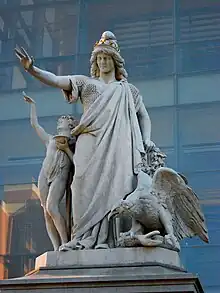
In the early 1880s, Ezekiel created eleven larger-than-life sized statues of famous artists. These were installed in niches on the façade of the Corcoran Gallery of Art's original building (later the Smithsonian's Renwick Gallery). In the early 1960s, they were removed to the Norfolk Botanical Garden in Norfolk, Virginia.
Among his other works was a memorial at VMI, Virginia Mourning Her Dead (1903), for which he declined payment.[7] It was installed in the small cemetery where six of the 10 VMI cadets killed at the Battle of New Market are buried. He also created a Confederate memorial which he called New South (1914); it was installed at Arlington National Cemetery. Many of his works were of famous leaders.
One word frequently used by Ezekiel as well as others to describe his statues[9]: 139, 164, 409, etc. is "colossal": his "genius often asserts itself in colossal figures and emblematic monuments".[34] His never-built statue of Johns Hopkins, founder of Johns Hopkins University, was to have been over 15 feet (4.6 m) high, with a "colossal" bust of Hopkins, in bronze, 21⁄2 times life size.[35] His most important statues are huge, and in one case he claimed that it was the largest statue ever made.
Lists of Ezekiel's works are found in the introduction to his Memoirs,[9]: 70–73 in an obituary in Art and Archaeology,[19] and in the New York Times.[6]
Ezekiel was a postwar friend of Robert E. Lee, who recommended he become "an artist",[3][4][9]: 124 and Ezekiel once remarked "the one work I would love to do above anything else in the world"[9]: 171 was a public sculpture of Robert E. Lee. But, despite entering at least four contests to do so, this ambition was not realized.[3]
Statues
- Religious Liberty (1876), commissioned by B'nai Brith, originally installed in Fairmount Park, Philadelphia, later moved to the National Museum of American Jewish History in the same city. "colossal."[19]: 230–231
- artists Phidias, Raphael, Durer, Michelangelo, Titian, Murillo, Da Vinci, Correggio, Van Dyke, Canova, Thomas Crawford (1879–84), originally installed in niches on the façade of the Corcoran Gallery of Art, Washington, DC., later moved to "Statuary Vista", Norfolk Botanical Garden, Norfolk, Virginia.[36] As of 2013 there was a campaign to restore them.[37]
- Spinoza statuette (1883), Hebrew Union College, donated by the artist for fundraising.[38]
- Mrs. Andrew Dickson White (Mary Amanda Outwater) (1889), Sage Chapel, Cornell University
- Christopher Columbus (1892), Arrigo Park, Chicago, Illinois.[39] Bronze, "faced with gold mosaic". Commissioned for the 1893 World's Columbian Exposition (Chicago World's Fair), which Ezekiel attended. Placed over the entrance to the Columbus Memorial building.[40]
- Jesse Seligman (1895)
- Thpmas Jefferson (1901), Louisville Metro Hall, Louisville, Kentucky.
- A 1910 replica is at the University of Virginia, Charlottesville, Virginia.
- Virginia Mourning Her Dead (1903), Virginia Military Institute, Lexington, Virginia. "Colossal."[19]: 234
- A replica is at the former Museum of the Confederacy, (the American Civil War Museum, Richmond, Virginia).
- Anthony J. Drexel (1904), Drexel University, Philadelphia, Pennsylvania.
- Blind Homer with His Student Guide 1881? (1907), University of Virginia, Charlottesville, Virginia.
- Jennie McGraw Fiske (1908), Sage Chapel, Cornell University
- Stonewall Jackson (1910), West Virginia State Capitol, Charleston, West Virginia.[41] and a replica at Lexington, Virginia
- Southern, at the Confederate Cemetery on Johnson's Island, Ohio, a 1910 commission from the United Daughters of the Confederacy.[42][43]
- John Warwick Daniel, (c. 1913), Lynchburg, Virginia.
- Confederate Memorial (1914), Arlington National Cemetery, Arlington, Virginia.[44]
- Edgar Allan Poe (Ezekiel's last work), 1915, Wyman Park, Baltimore, Maryland
- Neptune, date and location unknown, for Nettuno, Italy.
- Napoleon of St. Helena, statue in Rome, Italy.
- Edgar Allan Poe (1917), University of Baltimore, Baltimore, Maryland.[45]
Reliefs
- Israel, 1873 (Skirball Museum, Los Angeles)
- Jacob Ezekiel, the artist's father, 1874 (Skirball Museum, Los Angeles)
- Catherine Ezekiel, the artist's mother, 1874 (Skirball Museum, Los Angeles)
Busts
- Bust of Friedrich Hassaurek http://www.arcadja.com/auctions/en/ezekiel_moses_jacob/artist/80799/
- Robert E. Lee (1886), Virginia Military Institute Museum
- Isaac Mayer Wise, Hebrew Union College, Cincinnati
- Goldwin Smith, 1906, Goldwin Smith Hall, Cornell University
- Head of Anthony J. Drexel (1905), Drexel University, Philadelphia, Pennsylvania.
- Bust of General Robert E. Lee
- Bust of Percy Bysshe Shelley in the Keats-Shelley Memorial House, Piazza di Spagna, Rome.
- Bust of Franz Liszt.
- Bust of Jessica (1880), Smithsonian American Art Museum, Washington, DC.[46]
- Bust of Judith (c. 1880), Cincinnati Art Museum, Cincinnati, Ohio.[47]
- In 1888 he completed a bust of Hopkins professor Charles D. Morris.[35]
- Ecce Homo (1884), Cincinnati Art Museum, Cincinnati, Ohio.[48]
- Bust of Thomas Jefferson (1888), United States Capitol, Washington, DC.[49]
- Christ in the Tomb[19]: 231
- Napoleon at St. Helena
- The Martyr, or Christ Bound to the Cross
- David Singing his Song of Glory
- Judith Slaying Holofernes
- Jessica
- Portia
- the allegorical Jefferson Monument for Louisville, Kentucky, and a replica in front of the University of Virginia at Charlottesville
- Lord Sherbrooke Memorial in Westminster Abbey, London, England
- Senator Daniels at Lynchburg, Virginia
- Bust of Washington ("colossal"[50]: 189 )[18]: 5 ) in the Cincinnati Art Museum.
- Eve Hearing the Voice (1876), Cincinnati Art Museum, Cincinnati, Ohio.[51]
- Faith (1877), Peabody Institute, Baltimore, Maryland.[52]
- Bust of Governor Andrew Gregg Curtin (1912), Smith Memorial Arch, West Fairmount Park, Philadelphia, Pennsylvania.[53]
Archival material
The American Jewish Archives, in Cincinnati, has a "Moses Jacob Ezekiel Collection." It "includes original and photocopies of Ezekiel's correspondence and writings, photographs of many of his works, biographies, genealogies, memorial tributes, correspondence of Ezekiel's biographers, articles and newsclippings concerning Ezekiel and miscellaneous items." http://collections.americanjewisharchives.org/ms/ms0044/ms0044.html
Virginia Military Institute has two boxes of Ezekiel papers. "Included is correspondence to Virginia Military Institute Superintendent Edward West Nichols and others, 1867 – 1917, some relating to the design of the Battle of New Market memorial sculpture Virginia Mourning Her Dead; pen and ink sketches by Ezekiel (ca. 67 items); the typed manuscript of Ezekiel's autobiography, Memoirs from the Baths of Diocletian, and miscellaneous printed material."[15] Ezekiel's Memoirs, a fundamental source, were unknown until they were rediscovered in the Hebrew Union Archives by the two rabbis, who after much editorial work, prepared them for publication in 1975. They were called "gossipy" but "readable" in a review.[1]
Some additional material is in the archives of Congregation Beth Ahabah, of Richmond,[11] which contains the archive of Jacob Ezekiel's synagogue, Kahal Kadosh Beth Shalome, the Hebrew Union College of Cincinnati, on whose board of directors Jacob was secretary, and the organizations such as B'nai Brith and United Daughters of the Confederacy that commissioned sculptures.
Gallery
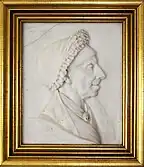 Bas relief of Sarah Workum, private collection.
Bas relief of Sarah Workum, private collection.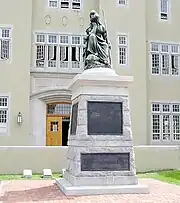 Virginia Mourning Her Dead (1903), Virginia Military Institute, Lexington, VA.
Virginia Mourning Her Dead (1903), Virginia Military Institute, Lexington, VA.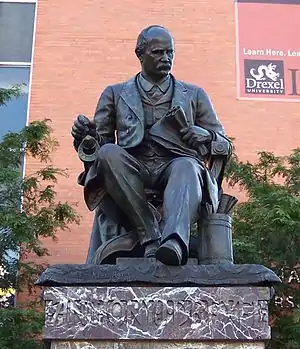 Anthony J. Drexel (1904), Drexel University, Philadelphia, PA.
Anthony J. Drexel (1904), Drexel University, Philadelphia, PA.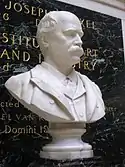 Bust of Anthony J. Drexel (1905), Drexel University, Philadelphia, PA.
Bust of Anthony J. Drexel (1905), Drexel University, Philadelphia, PA. Homer (1907), University of Virginia, Charlottesville, VA.
Homer (1907), University of Virginia, Charlottesville, VA.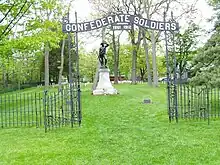 The Lookout (1910), Confederate Cemetery, Johnson's Island, OH.
The Lookout (1910), Confederate Cemetery, Johnson's Island, OH. Jefferson Monument (1910), University of Virginia, Charlottesville, VA.
Jefferson Monument (1910), University of Virginia, Charlottesville, VA. Bust of Andrew Gregg Curtin (1912), Smith Memorial Arch, Philadelphia, Pennsylvania.
Bust of Andrew Gregg Curtin (1912), Smith Memorial Arch, Philadelphia, Pennsylvania.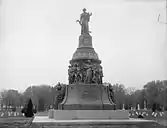 Confederate Memorial (Arlington National Cemetery) (1914), Arlington, VA.
Confederate Memorial (Arlington National Cemetery) (1914), Arlington, VA.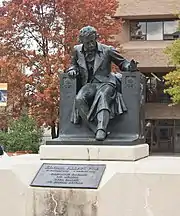 Statue of Edgar Allan Poe (1917), University of Baltimore, Baltimore, Maryland.
Statue of Edgar Allan Poe (1917), University of Baltimore, Baltimore, Maryland.
'
In popular culture
Ezekiel was portrayed by Josh Zuckerman in the 2014 film Field of Lost Shoes, which depicted the Battle of New Market.
Ezekiel is the sculptor Askol in Carel Vosmaer's novel The Amazon, in which Ezekiel's studio is described in detail,[9]: 15 [54] It is also described in Mary Agnes Tincker's The Jewel in the Lotus;[9]: 66 [55] "the opening pages depict the studio of Salathiel, the sculptor, the original of which character in the novel was Moses Ezekiel."[18]: 27
A poem about his Israel was written by Pietschmann, of Berlin.[18]: 10–11
Gabriele d'Annunzio wrote a poem, "To Mole Ezekiel," in 1887.[9]: 459
A description of his studio by Lilian V. de Bosis was published in the May 1891 issue of 'kTye Esquiline.[18]: 25–26
See also
- Herbert Barbee
- Edmonia Lewis, the other American sculptor in Rome
Notes
- He may have been the fifth of 14 children.[10][11]: 14
- He may have had four brothers and nine sisters.[8]: 3
- "My father was so very good-hearted that he ruined himself by signing bonds for some of his relatives who afterwards failed in business. That reduced my parents to absolute poverty for a long time."[9]: 88
References
- Lindquist-Cock, Elizabeth (May 1, 1975). "Moses Jacob Ezekiel (Book Review)". LJ: Library Journal. Vol. 100, no. 9. pp. 841–842.
- Nash (2014), p. xi.
- Eisenfeld, Sue (February 2018). "Moses Ezekiel: Hidden in Plain Sight". Civil War Times Magazine. Archived from the original on 2019-02-02. Retrieved 2019-02-01.
- Moehlman, Lara (September 21, 2018). "The Not-So Lost Cause of Moses Ezekiel". Moment. Archived from the original on January 21, 2019. Retrieved January 21, 2019.
- Eisenfeld, Sue (December 1, 2017). "Should We Remove Confederate Monuments—Even If They're Artistically Valuable?". The Forward. Archived from the original on January 21, 2019. Retrieved January 21, 2019.
- "American Sculptor, Moses Ezekiel, Dies [obituary]" (PDF). New York Times. March 28, 1917.
- Feldberg, Michael (May 15, 2018). "Sir Moses Jacob Ezekiel: The Jew Who Sculpted Confederate Monuments". Artes Magazine. Archived from the original on February 20, 2019. Retrieved February 19, 2019.
- Cohen, Stan; Gibson, Keith (2007). Moses Ezekiel : Civil War soldier, renowned sculptor. Missoula, Montana: Pictorial Histories Publishing Company. ISBN 9781575101316.
- Ezekiel, Moses Jacob (1975). Gutmann, Joseph; Chyet, Stanley F. (eds.). Memoirs from the Baths of Diocletian. Wayne State University Press. ISBN 978-0814315255.
- "Jacob Ezekiel (necrology)". Publications of the American Jewish Historical Society. Vol. 9. 1901. pp. 160–163. JSTOR 43058859.
- Heltzer, Herbert L. (February 2012). "Moses Ezekiel: The Search for a Reputation" (PDF). Generations: Jewish Voices of the Civil War. Vol. 12, no. 1. pp. 14–16. Retrieved March 9, 2019.
- "B'nai B'rith Members Plan to Revive Local Branch on 90th Anniversary of Order". Syracuse Herald. October 16, 1932. pp. 1, 6.
- "Mrs. Jacob Ezekiel". Richmond Dispatch. July 12, 1881. p. 2. Archived from the original on December 14, 2019. Retrieved February 2, 2019.
- "Moses Ezekiel". Hallowed Ground. American Battlefield Trust. Summer 2010. Archived from the original on 2015-07-13. Retrieved 2015-07-11.
- Virginia Military Institute Archives. "Moses J. Ezekiel papers". Archived from the original on February 28, 2019. Retrieved February 28, 2019./
- "Examination of the Richmond Hebrew Sunday School". Richmond Dispatch. July 3, 1868. p. 1.
- Findsen, Owen (October 26, 1986). "Sculptor Moses Ezekiel 'Rediscovered'". Cincinnati Enquirer. p. 46.
- Philipson, Rabbi David (1922). "Moses Jacob Ezekiel". Publications of the American Jewish Historical Society. Vol. 28. pp. 1–62.
- Bush-Brown, Henry K. (1921). "Sir Moses Ezekiel: American Sculptor". Art and Archaeology. Vol. 11. pp. 227–234. Archived from the original on 2020-07-19. Retrieved 2020-07-27.
- "Obituary. Sir Moses Ezekiel". American Art News. March 31, 1917. p. 4.
- Oppenheim, Samson D. (1917). "Moses Jacob Ezekiel". American Jewish Yearbook. pp. 227–232.
- C. M. S. (September 15, 1889). "Gallery and Studio". Brooklyn Daily Eagle. p. 11.
- Chyet, Stanley E. (198). "Moses Jacob Ezekiel: Art and Celebrity" (PDF). American Jewish Archives Journal. Vol. 35, no. 1. pp. 41–51.
- Buckler, Helen (1954). Doctor Dan : pioneer in American surgery. Boston: Little, Brown and Company. OCLC 964464.
- The Booker T. Washington Papers, Vol.9, footnote, p. 396, November 1907, U. of Illinois Press Archived 2007-10-20 at the Wayback Machine
- Helen Buckler, Doctor Dan: Pioneer in American Surgery, (originally published before 1923; reprinted by Nabu Press, 2011), pp. 147-58, 226-27. Another edition, published in 1968, is Buckler's Daniel Hale Williams, Negro Surgeon.
- O'Brien, Peg (June 16, 1954). "Famous Negro Surgeon Once Was Barber Here". Janesville Daily Gazette (Janesville, Wisconsin). p. 22. Archived from the original on June 7, 2019. Retrieved May 28, 2019.
- Nash (2014), p. 78.
- Nash (2014), pp. xi, 50, 78-79, 100, 119-120.
- Making of America Project (1939). The North American Review. University of Northern Iowa.
- Levy, Florence Nightingale (1917). American Art Directory, Volume 14. The American Federation of the Arts. p. 322.
- Kaufman, Ben L. (September 27, 1975). "HUC Alumni Save Document". Cincinnati Enquirer.
- Shapiro, T. Rees (August 18, 2017). "Descendants of Rebel sculptor: Remove Confederate Memorial from Arlington National Cemetery". Washington Post. Archived from the original on January 20, 2019. Retrieved February 1, 2019.
- Morais, Henry Samuel (1894). The Jews of Philadelphia: Their History from the Earliest Settlements to the Present Time. Philadelphia.
{{cite book}}: CS1 maint: location missing publisher (link) - "Johns Hopkins. The Effort to Erect a Monument to His Memory to Be Renewed". Baltimore Sun. September 23, 1892. p. 8. Archived from the original on March 27, 2019. Retrieved March 15, 2019.
- Statuary Vista Archived 2011-07-18 at the Wayback Machine from Norfolk Botanical Garden.
- NorfolkTV (October 10, 2013), Moses Ezekiel Statues from the 1800s, City of Norfolk
- "Artists and Charity". American Israelite (Cincinnati, Ohio). October 12, 1883. p. 7. Archived from the original on March 27, 2019. Retrieved March 27, 2019.
- Columbus Statue Archived 2011-07-18 at the Wayback Machine from Waymarking.com.
- "Items of Interest. Chicago". Jewish South. November 24, 1893. p. 7.
- "Stonewall Jackson". Archived from the original on 2019-02-26. Retrieved 2011-03-10.
- United States Department of Veterans Affairs. "Confederate Stockade Cemetery". Archived from the original on July 9, 2019. Retrieved March 11, 2019.
- "Unveil Monument to Mark the Resting Place of Two Hundred and Six Confederate Soldiers". Sandusky Daily Register. June 8, 1910. pp. 1 and 7.
- Confederate Soldiers Memorial Archived 2005-11-26 at the Wayback Machine from Arlington National Cemetery.
- Poe Statue Archived 2010-12-25 at the Wayback Machine from University of Baltimore Law School.
- Jessica Archived 2014-05-02 at the Wayback Machine from Flickr.
- Judith from Cincinnati Art Museum.
- Ecce Homo, (sculpture) Archived 2021-07-18 at the Wayback Machine from Smithsonian Institution CollectionsSearchCenter.
- Jefferson Archived 2018-09-26 at the Wayback Machine from U.S. Senate.
- Virginia, University of (April 1907). "The Ezekiel Bronzes". The Alumni Bulletin. 7 (2): 188–192.
- Eve Hearing the Voice from Cincinnati Art Museum.
- Faith Archived 2011-12-14 at the Wayback Machine from Peabody Art Collection.
- Governor Curtin bust Archived 2010-12-19 at the Wayback Machine from Philadelphia Public Art.
- Vosmaer, Carl (1884). The Amazon. New York: T. F. Unwin..
- Tincker, Mary Agnes (1884). The Jewel in the Lotus. London: J.B. Lippincott & Co.
Bibliography
- Cohen, Stan and Keith Gibson. Moses Ezekiel: Civil War Soldier, Renowned Sculptor, Pictorial Histories Publishing Company, Inc., 2007. ISBN 1-57510-131-9
- "Obituary. Sir Moses Ezekiel". American Art News. March 31, 1917. p. 4.
- Ezekiel, Moses Jacob (1975). Gutmann, Joseph; Chyet, Stanley F. (eds.). Memoirs from the Baths of Diocletian : or Memoirs of a Southern veteran. Detroit: Wayne State University Press. ISBN 978-0-8143-1525-5.
First publication.
- Leepson, Marc. "Sculpting the Cause", Civil War Times Illustrated, Vol. 46, Issue 9, November–December 2007.
- Nash, Peter Adam (2014). The Life and Times of Moses Jacob Ezekiel: American Sculptor, Arcadian Knight. Madison–Teaneck, New Jersey: Fairleigh Dickinson University Press. ISBN 978-1611476712.
- Preston, Margaret J. (June 1883). "The American Sculptor Ezekiel". Lippincott's Magazine of Popular Literature and Science: 620–623.
- "Ezekiel, Sculptor, Arrives: Here to Attend Unveiling of His Statue of Jefferson in Charlottesville". New York Times. May 25, 1910. p. 9.
- Wrenshall, Katharine H. (November 1909). "An American Sculptor In Rome: The Work of Sir Moses Ezekiel". The World's Work: A History of Our Time. XIX: 12255–12263. Retrieved 2009-07-10.
Video
- NorfolkTV (October 10, 2013), Moses Ezekiel Statues from the 1800s, City of Norfolk